
Traveling tiny houses – RV vs. Tiny home, Which One is Better?
Traveling in an RV or Tiny House, Which One is Better?
The tiny house movement isn’t just about downsizing and setting up a living space somewhere off-grid. Part of the appeal is being able to travel in your dream home from place to place, laying down temporary roots wherever you go. You can do that with a tiny home on wheels or an RV (recreational vehicle), the latter of which is built for road trips and staying at campgrounds. It can be tough to figure out which will be the best for you, so we’ll help you weigh out the pros and cons.
You’ll find a list below of some of the most important advantages and disadvantages for living in a traveling tiny house or RV to help you make your choice. Let’s hit the road to Colorado with the benefits of a tiny home on wheels!
Advantages of a Tiny Home
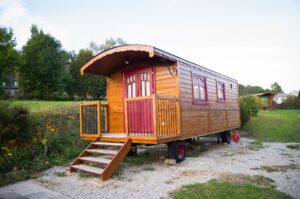
They look more traditional:
For some people, RVs might just feel like a temporary living space, but tiny homes can give you that home sweet home feeling you’re looking for. They look and feel more like a traditional full size house, so overall, you’ll probably feel more like it’s a permanent home — even if it’s on wheels. It’s easier to make them look more well designed (we’ll get into this more next) for the most part, and that’s great to consider if you plan on blogging or taking photos of your space to share with others. Imagine that it’s an AirBnB on wheels!
They’re easier to customize:
Compared to RVs, tiny homes can be a lot easier to customize, since you’ll often be starting from the ground up and can plan out the foundation from the jump. It isn’t as easy to gut out and alter an RV once you buy one, although some manufacturers can sell you one with a custom floor plan. Most of the time, though, you can control exactly how you want your tiny home to look, and it’s a lot easier to build DIY additions or make upgrades later on.
They’re usually more insulated:
A major benefit for tiny homes is that they’re closer to real homes in terms of the foundation and insulation. It’s so much easier to control the temperature of your space in a tiny house compared to an RV. You’ll need to think about your comfort, and if you plan on living anywhere with harsh weather conditions, either cold or warm, you might want to consider a tiny house first.
Cons for Tiny House Travel
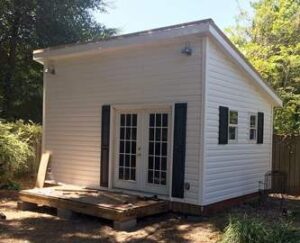
Traveling in a tiny home does have some downsides compared to RVs — here are some of the most important ones to consider.
They can have limited mobility:
You can use a towing vehicle of some sort to carry your wheeled tiny house from place to place when needed, but they aren’t as easy to transport as an RV, which is already designed for driving.
And, while tiny houses are generally more insulated and weatherproof, they might not be designed to be on the road for long periods of time. There’s lots of dust and debris on the road that can fling up into your house’s shingles or roof tiles, which can lead to damage over time. RVs account for this in the design process, so long journeys can be both easier and less damaging in the long run.
They’re more complicated to insure:
Tiny home owners need to be aware of the more complicated insurance process compared to RV campers. RV’s have strict regulations they need to follow (such as the RVIA), which means campgrounds and national parks feel more comfortable about letting them park overnight and they’re more straightforward to insure. Custom built tiny houses don’t have the same regulations, so they might not be allowed to park for an overnight stay. There’s also some grey area about whether you’ll qualify for a standard homeowner policy or RV insurance (if the home is on wheels), so you’ll need to check in with your insurance company beforehand.
They’re usually more expensive per square foot:
It may be a bit of a surprise, but tiny homes can end up costing more per square foot than an RV. Most tiny homes will be somewhere between $125 and $300 per square foot, while it’ll usually be somewhere in the low hundreds for RVs, especially if you’re buying an older used camper. On the bright side, the value of a tiny home won’t depreciate like it does for the vehicle, so it’ll be worth the investment if it can fit comfortably in your budget.
Advantages of an RV
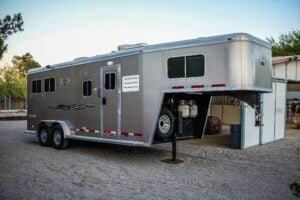
RVs solve a lot of the problems commonly found in tiny homes. They’re homes on wheels designed for mobility, can be cheaper depending on the modifications, and they’re often more affordable per square foot than a tiny home, so you can have space for larger kitchens or a washer and dryer space. Here are another few advantages that can sweeten the deal:
You’ll blend in more easily:
Maybe you’re someone who doesn’t want all the attention that tiny homes get, and you’d just prefer to blend into the crowd and socialize on your own terms. You’re more likely to get that with an RV small camper — mobile tiny homes can pull crowds, especially if you’re parked in a campground and everyone wants a tour of your stylish space. RVs are the more common choice to travel with, so you won’t stand out with one.
Looking for a great camping site to explore in the US? Check out this lovely list of 20 of the best (and free!) campsites to park in.
They often have better sleeping arrangements:
With tiny homes, chances are your bedroom will be up in a loft above a space like your living room, since that’s one of the easier ways to place a bed and maximize your overall space. But, if you don’t want to (or are unable to) climb up and down stairs multiple times a day, that can be a huge deterrence. With some loft spaces you might be super close to the ceiling, too, and you could bump your head if you aren’t careful. RVs usually have a full bedroom on the ground floor, which means you can avoid the stairs.
It’s easier to get financing:
If you don’t have the money upfront for your new tiny home or RV, keep in mind that finding a bank loan for an RV is usually easier. They’re almost as common as car loans, except your financing period will likely be a lot longer. Banks are less likely to fund a tiny house that falls somewhere between a home and an RV, but it isn’t impossible, so be sure to ask your bank first to figure out all the details.
Cons for Living in an RV
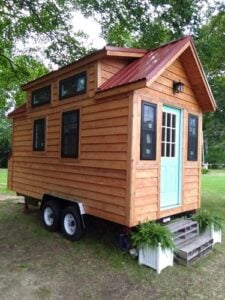
RVs have their perks, but that doesn’t mean choosing one over a tiny home is easy — there are some downsides you’ll need to think about.
They’re more difficult to design well:
Part of the reason why tiny homes appear more popular is that they’re easier to make minimalist and beautiful — which makes for perfect social media posts to spread the word. There are some beautiful RVs, sure, but most of the time they don’t look the best, and it can take a lot more effort to pretty them up. There isn’t much that can be done about the outside of your RV, either. It will likely always look like a camper unless you’re willing to put in some extra time and money.
They generally use more energy to heat and cool:
RVs normally have some problems when it comes to extreme temperatures, since they aren’t as insulated as tiny homes. They aren’t great at keeping the heat and cold out, so you could end up spending a lot more money a month and energy in the long run, depending on where you are geographically. If you’re anywhere cold, you’ll definitely want to consider a well-insulated tiny house.
If you do happen to be set on RVs, hope is not lost — you can alter them and add insulation or hire someone to do it for you. It will just take some extra coin upfront, so factor that into your overall cost while budgeting.
Our final verdict
There isn’t a clear winner here. For people who prefer a minimalist aesthetic, a beautifully designed space that’ll bring lots of attention, and the feeling of a more permanent home, a tiny house will likely be what you’re after. If you’d rather avoid the complicated insurance, are working with a smaller budget, and don’t so much mind the camper aesthetic, then an RV sounds like a great choice for you. You’ll also probably want an RV if you plan to be on the road often.
Frequently Asked Questions
Now that you’ve learned some of the key differences between a tiny house or an RV when living on the road, you might still have some questions — here are our answers to a few of the most common ones. Be sure to leave a comment below if you still have any questions, stories, or advice to share.
What are some of the best trucks and tow vehicles?
If you’ve picked out a wheeled tiny home and need a new truck to tow it, not all vehicles can handle the task so there are a few important factors to consider. First, you’ll need to know how much your tiny house weighs. The heavier your house is, the more powerful your truck needs to be, while light weight homes might not need as strong of a truck. The tiny house company or manufacturers should be able to tell you how much it weighs after buying, but if you build it yourself, it’s a good idea to weigh all your materials and furniture beforehand and make a list or spreadsheet. Once you have the weight (or a ballpark of it) look for a truck with a suitable towing capacity.
Keep in mind, too, that most diesel engine cars can give you better towing capacity, since its torque is higher. But they can be a bit more expensive, especially since diesel can sometimes be more costly than regular gas fuel in the US.
Here’s a list of some of the newest truck and SUV models to check out first:
- 2022 Ford Expedition
- 2022 Ford Ranger XL
- 2022 Ram Chassis Cab
- 2022 Chevrolet Silverado 1500
- 2021 Chevrolet Tahoe
- 2021 GMC Yukon
What factors should I look into when looking to road-trip across the country with a tiny house?
There’s many logistics you’ll need to think about and manage on a road-trip across the country, and if you’re still building your home, it’s good to keep them in mind to set yourself up for success.
- Size: The larger and heavier your tiny house or travel trailer is, the more difficult it will be to transport from place to place. You might need a truck with a higher towing capacity, or a specific trailer that’ll make it easier to turn and maneuver.
- Parking: As we mentioned before, parking a tiny house overnight at campgrounds or national parks isn’t always easy. Some have more strict rules about overnight stays, and RVs might have an easier time, so it’s a good idea to plan out your route beforehand and make sure you know where you can park overnight.
- Weather: When planning your trip, think about the weather and seasons of your destination — if it’s going to be cold and snowy, make sure your tiny home is well insulated. Some areas might be super hot depending on the month, too, which might be uncomfortable depending on your heat tolerance.
- Budget: Before you embark on your journey, make sure you account for all expected (and unexpected!) costs: you don’t want to be stranded somewhere without any cash available. Also, keep in mind that the heavier your house, the more gas you’ll consume, so make sure that you plan accordingly in your budget. If you want to estimate your fuel costs, use this calculator from the U.S Department of Energy.
Can you live in a tiny house and still have a social life?
Of course! The beauty of mobile tony homes or RVs is that you can park anywhere you’d like (following all applicable laws), whether that’s in a tiny house community with other folks or off-grid in the middle of nowhere. If a social life is what you’re after, you’ll have lots to talk about with the other tiny home owners in the lot, and if you’d prefer to live in solitude instead, you can drive off into the sunset and find your own little corner of the world.
8 Best Tiny House Refrigerators for 2023
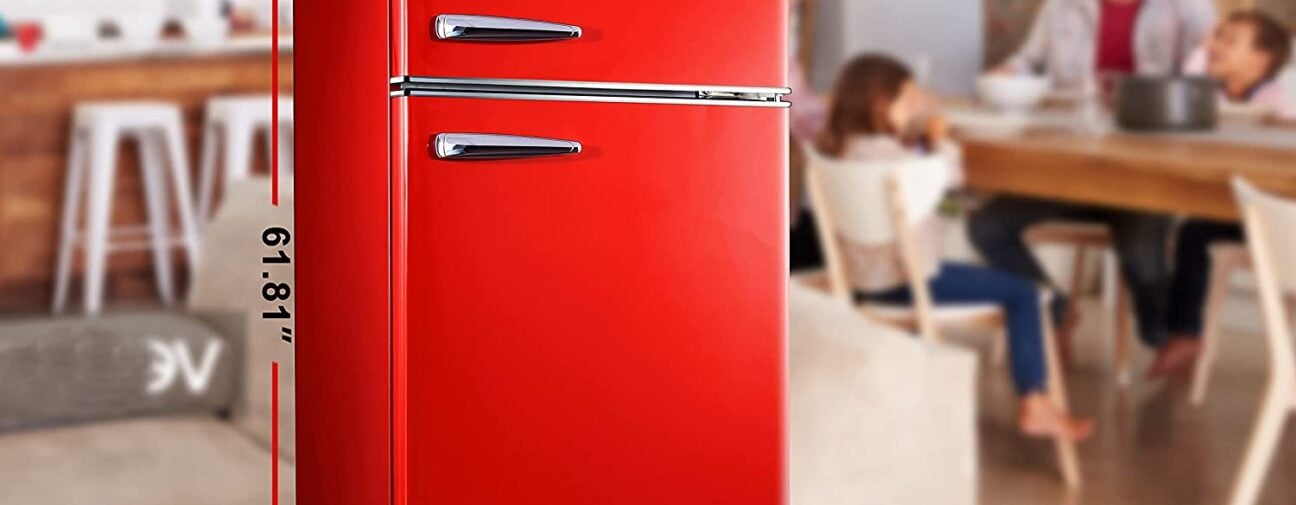
You’ll probably cook in your tiny home kitchen every day, so it’s one of the most important spots to consider when planning out your floorplan and appliances, like a refrigerator. Finding the best tiny house kitchen fridge can be tough given the storage space and energy constraints, but we’re here to help.
You’ll first need to decide whether you want an electric or propane refrigerator for your tiny house — we’ll walk you through some of the key differences between the two. Plus, you’ll find an outline of some fridge characteristics you should be on the hunt for while you shop. You’ll then be able to browse the list hopefully knowing exactly what to look for!
When you buy through links on our site, we may earn an affiliate commission. As an Amazon Associate, we earn from qualifying purchases.
Types of refrigerators:

Electric: You’re probably used to using electric fridges, since they’re the most common in traditional homes or apartments, but you can usethem both on and off-grid. They’re easy to set up and use, since for the most part you can keep your food cool after just plugging it in.
If you’re worried about using too much electricity in an off-grid home, you can find energy efficient fridges for a higher upfront cost, or, opt for a fridge that runs on solar power to harness electricity from nature.
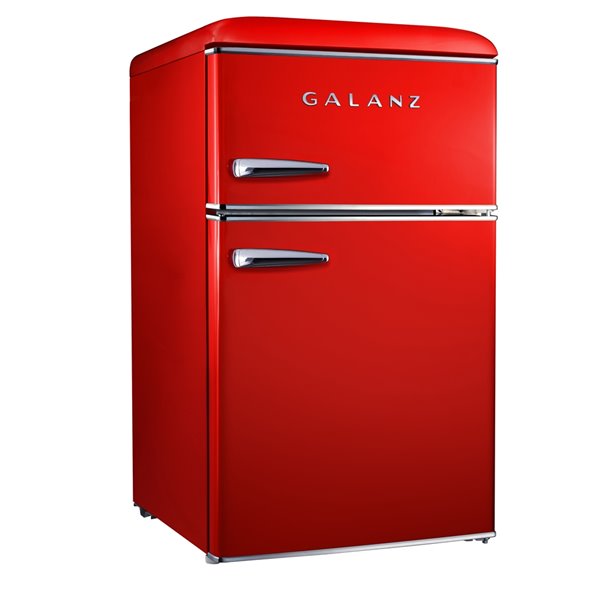
Propane: These fridges can be a bit more expensive, but they’re the best for anyone who wants to live completely off-grid and who might have limited access to power. In some areas, propane can be bought more cheaply than other cities, so check out how much it’ll be beforehand to get a full idea of the upkeep costs.
Keep in mind that the propane burner box inside these fridges generates some carbon monoxide — see our frequently asked questions at the end of this page to learn more about how they work. You’ll need to set up a venting system to keep everyone in your tiny home healthy and safe.
What makes a good tiny home fridge?
That’s a loaded question! There are many key characteristics to consider, like the size and interior capacity of the fridge, how energy efficient it is, how much noise it makes, or how well it fits within your budget. Some can even be built into your cabinets to save space. What’s good for one shopper might not be so great for the next.
With that in mind, we put together this list below of some of the best tiny house refrigerators for 2022 based on some of these different characteristics and what kind of tiny home owner they’d be great for.
Here’s our list of best tiny house refrigerators for 2022!
1. Best built-in tiny house fridge and freezer: Summit Appliance 24″ Counter Depth Bottom Freezer 11.6 cu. ft. Refrigerator
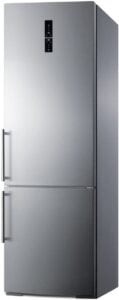
Product specifications
- Fridge Capacity: 8.2 cubic feet
- Freezer Capacity: 3.5 cubic feet
- Powered By: Electricity
- Dimensions: 74.38” x 23.63” x 27.25”
- Weight: 175 lbs.
- Warranty: 1 year limited
The Good
- Stylish stainless-steel design
- Precise and smart adjustable thermostat temperature controls
- Thin, but has a roomy interior
- Adjustable shelves
The Bad
- Might be louder than you’re used to
This bottom freezer refrigerator is designed to be built into your cabinetry — they can blend in seamlessly and have a high-end look. This one from Summit Appliance has a sleek stainless-steel design, and has plenty of useful features, including adjustable spill-proof glass shelves, large crisper drawers with humidity controls, and fridge and freezer boost controls that can cool each one down more quickly after being opened.
This model is thinner than many other kitchen fridges, too, so it’ll be easier to fit into your floor plan — you don’t need to sacrifice fridge space just because you’re working with a smaller kitchen. It’s on the pricier end of the spectrum, but if you’re ready to invest, you probably won’t regret it.
2. Best freestanding tiny house fridge and freezer: Galanz GLR10TRDEFR True Top Freezer Retro Refrigerator
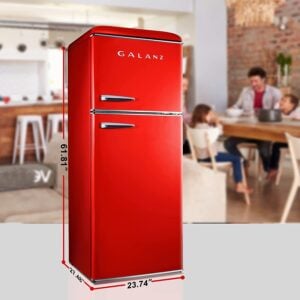
Product specifications
- Fridge Capacity: 7.42 cubic feet
- Freezer Capacity: 2.42 cubic feet
- Powered By: Electricity
- Dimensions: 23.74” x 27.48” x 61.81”
- Weight: 125.7 lbs.
- Warranty: 1 year limited
The Good
- Good build quality
- Runs relatively quietly
- Fits in smaller areas, but has a spacious interior
- Available in many sizes
- Multiple Color Options
- It’s Energy star rated
The Bad
- Some buyers received a faulty fridge
If you’re looking for a well-rounded small fridge for your tiny home that has plenty of space for food, but doesn’t take up too much kitchen space, consider this choice from Galanz. It’s a freestanding fridge with swing doors and bright internal lighting, and there’s a spacious freezer on the top. It also runs pretty quietly compared to other fridges, so you won’t be kept up all night listening to a loud hum. The glass shelves are adjustable to accommodate different foods and drinks, which is helpful.
This fridge is relatively energy efficient, too, and uses a low energy consumption compressor. Bonus: it also has a fun retro design, and you can choose from four different color options, like white, blue, or a vibrant red. You can also choose from five different sizes, so it’s easy to match this fridge to your kitchen.
3. Best tiny house propane refrigerator: Unique Off-Grid White 8-cu ft Standard-Depth Propane Top-Freezer Refrigerator
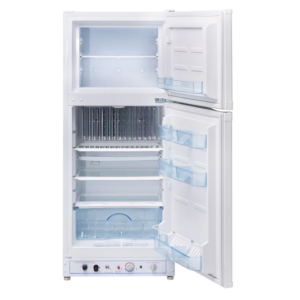
Product specifications
- Fridge Capacity: 6.3 cubic feet
- Freezer Capacity: 1.7 cubic feet
- Powered By: Propane
- Dimensions: 65.5” x 23.75” x 29.25”
- Weight: 192 lbs.
- Warranty: 1 year limited
The Good
- Perfect for off-grid homes and cabins
- Reversible doors
- Roomy interior
- Smudge-resistant finish
The Bad
- Expensive compared to some other options
Many off-grid tiny homes will require some creative power solutions, and propane fridges are a great choice for anyone who can’t supply enough electrical power to their kitchen. If you’re wondering about the ignition and the interior lights, they’re powered by battery. This fridge is perfect for cabins and lake houses, too, and it has a stylish design that’ll look great in most kitchens.
This fridge is decently spacious with 8 cubic feet capacity in total, and the glass shelves inside are adjustable, so you can configure it to best suit your needs — you won’t need to struggle to fit large bottles in your fridge anymore.
4.Best undercounter mini refrigerator: Danby Entertainer 117 Cans (12 oz.) Freestanding Beverage Refrigerator
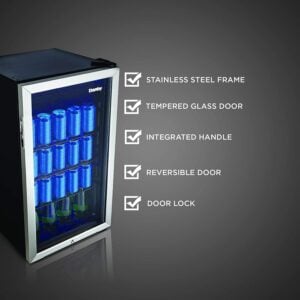
Product specifications
- Fridge Capacity: 3.1 cubic feet
- Freezer Capacity: N/A
- Powered By: Electricity
- Dimensions: 33.5” x 17.5” x 19.68”
- Weight: 72.75 lbs.
- Warranty: 1 year
The Good
- 4 adjustable shelves
- Perfect for a small kitchen
- Easy installation
- Bright blue LED lighting
- Handle-free design
- One of the most compact refrigerators on our list
The Bad
- No freezer
- Very limited space
- Has a weird humming sound
Here’s a great mini fridge to consider if you don’t have the room for (or just don’t want) a full-sized one. You can either install it as a freestanding fridge or under a counter if you’d prefer to save some space in your kitchen. It’s designed for drinks (storing up to 117 12 oz. cans!) but since the shelves are all adjustable, you can move them around to make room for your food, too.
Don’t feel limited to just installing it in your kitchen, either. The reversible doors and sleek design make it easy to install anywhere in your home, like in a living room, game room, garage, den or basement. Fresh drinks will always be cool and ready.
5. Best small fridge and freezer: Costway Refrigerator Small Freezer Cooler Fridge Compact 3.2 cu ft. Unit
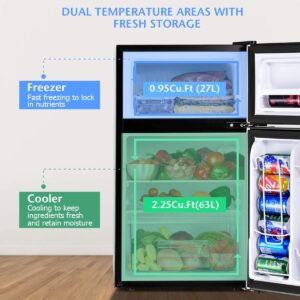
Product specifications
- Fridge Capacity: 2.2 cubic feet
- Freezer Capacity: 1 cubic foot
- Powered By: Electricity
- Dimensions: 19” x 17.5” x 34”
- Weight: 52 lbs.
- Warranty: 60 days
The Good
- Small and out of the way, but still has a freezer
- Very light fridge
- Isn’t too noisy
- Affordably priced
- Sleek design
The Bad
- No separate temperature controls for fridge and freezer
For those very tight on kitchen space, here’s a space saving fridge from Costway that will fit neatly into most setups. It’ll keep all your drinks and a small amount of food cold and fresh, and there’s still a freezer for storing meat or your favorite ice cream. You’ll also find a full shelf, small shelf, and a crisper in there, so there’s lots of storage options.
Be warned, this fridge is only for those that know they have a small space. If you’re an avid cook, though, and tend to store lots of fresh food in your home, you might want to spring for one of the larger fridges listed here — if you have enough space for one.
6. Best mini fridge with the smallest capacity: Caynel Portable Mini Fridge
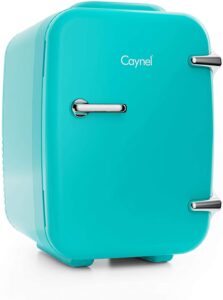
Product specifications
- Fridge Capacity: 4 Liters
- Freezer Capacity: N/A
- Powered By: Electricity
- Dimensions: 10” x 7” x 11”
- Weight: 4.75 lbs.
- Warranty: 1 year
The Good
- Fun and compact design
- Energy efficient
- Can warm things up, too
- Available in six cute colors
- Functions perfectly as a backyard’s fridge
The Bad
- Not large enough to use for cooking in your kitchen
This is a very small fridge, but that might be exactly what you’re looking for. It can be used for small items from cans of soda to skincare, and while it’s definitely not large enough to store foods to cook, it’s portable and great to travel with. You can also store it neatly on a countertop, to save space elsewhere, then bring it on the road stocked with snacks.
Also fun: it comes in a variety of lively colors, and you can also use it to warm your foods up to 140 degrees Fahrenheit. Any way that you use it, it’s energy efficient and environmentally friendly since there’s no freon used to cool things, which you might find in other portable mini fridges or air conditioners.
7. Best energy saving refrigerator: GE Appliances 28″ Energy Star Top Freezer 17.52 cu. ft. Refrigerator
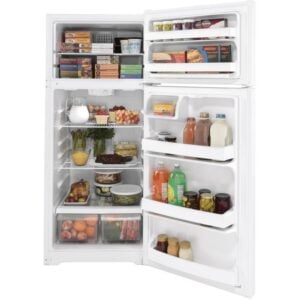
Product specifications
- Fridge Capacity: 13.49 cubic feet
- Freezer Capacity: 4.03 cubic feet
- Powered By: Electricity
- Dimensions: 66.875” x 28” x 30.5”
- Weight: 165 lbs.
- Warranty: 1 year limited
The Good
- Energy efficient, and can save money in the long run
- Sleek design
- Glossy appearance that’s easy to clean
- Operates quietly
- Reversible door
The Bad
- On the pricey side
If you’re worried about power consumption and want an efficient fridge, choose an Energy Star-certified model like this one from GE Appliances. It’ll save you money and energy in the long run, without sacrificing any quality. It’s also built with temperature controls on the front, so it’s easy to change the temperature for both the fridge and freezer.
Inside the fridge, you’ll find movable racks so it’s easy to adjust based on the size of your food items, and the LED lighting has a more natural looking light, which can help you spot which fruits and vegetables need to be used up first.
8. Best tiny house refrigerator with ice maker: Whirlpool WRS571CIHZ 21 Cu. Ft. Stainless Counter Depth Side-by-Side Refrigerator
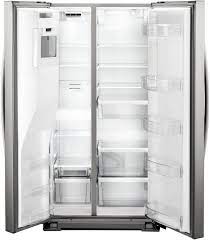
Product specifications
- Fridge Capacity: 20.6 cubic feet
- Freezer Capacity: N/A
- Powered By: Electricity
- Dimensions: 68.9” x 36” 29.8”
- Weight: 320 lbs.
The Good
- Built-in water and ice dispenser is convenient
- Lots of fridge and freezer space
- Frameless glass shelves
- Flexible storage options
The Bad
- Large and expensive
With a fridge like this Whirlpool model, you won’t need to open the fridge door to get filtered water and fresh ice. This has the most storage on this list, but also uses the most power and takes up the most room, so it’s great for tiny home owners who love to cook and are going to dedicate plenty of space to their kitchen.
Inside the unit is a smart temperature management system that senses and adapts the temperature to make the perfect environment for whatever’s in there, and most of the bins inside are adjustable so you can make all your food and packages fit properly.
We hope that you found this list of tiny house refrigerators helpful, and that you’re well on your way to planning your dream tiny home kitchen! Whether you’re looking for a dishwasher, dryer washer combo, other kitchen appliances or even a toaster oven – SuperTinyhomes is your guide to all things tiny homes!
Our Frequently Asked Questions about Tiny House Fridges
Every kitchen needs a great fridge to keep your food cold and fresh, whether its full sized or tiny. Even if you just need to store drinks and snacks, you’ll appreciate having one available. As you’ve probably noticed, there are many different fridges available, so it’s easy to find one that’ll suit your specific needs.
If you need help planning the rest of your tiny kitchen, check out our roundup of the best tiny home cooktops and ovens, and if you haven’t yet decided on a bedroom, here are some tiny house bed ideas.
Each of these are a type of cooling system that have some pros and cons, but in most cases, compressor fridges will be the way to go. They keep the inside of your fridge cool using a compressor, that’s powered by either electricity or a battery. They’re generally more efficient and can maintain lower temperatures inside, and if you’re in a mobile tiny home, they work great either flat or on an incline. They tend to be noisier than absorption fridges, though, you might need to use a solar battery since they rely on so much power.
Absorption cooling systems instead uses ammonia, gas (like propane), and heat to create the cooling action inside. You won’t need a lot of power to run them, usually just a battery for the ignition or lighting, and the system doesn’t make any sound while running. You’ll have troubles running these fridges on an incline, though, and you’ll need to keep in mind the cost of propane.
There isn’t really a hard and fast rule for deciding what tiny house refrigerator dimensions you should go with; everyone’s needs are going to be a bit different. There are, however, a few things to keep in mind.
Anyone who loves to cook is going to need plenty of space to store fresh food. You don’t want to get a fridge so large that you fill to the brim, though, only to realize later on that most of your food in the fridge went past the expiration date. Try to gauge how often you cook and how many things you tend to store to the fridge size you pick.
Also, think about the size of items you buy — if you often buy large soda bottles, for example, make sure you pick a fridge with adjustable shelves to fit them all. Or, if you like to keep lots of frozen meat on hand, make sure you pick a fridge with a roomy freezer.
7 of the Greatest Tiny Home Ovens
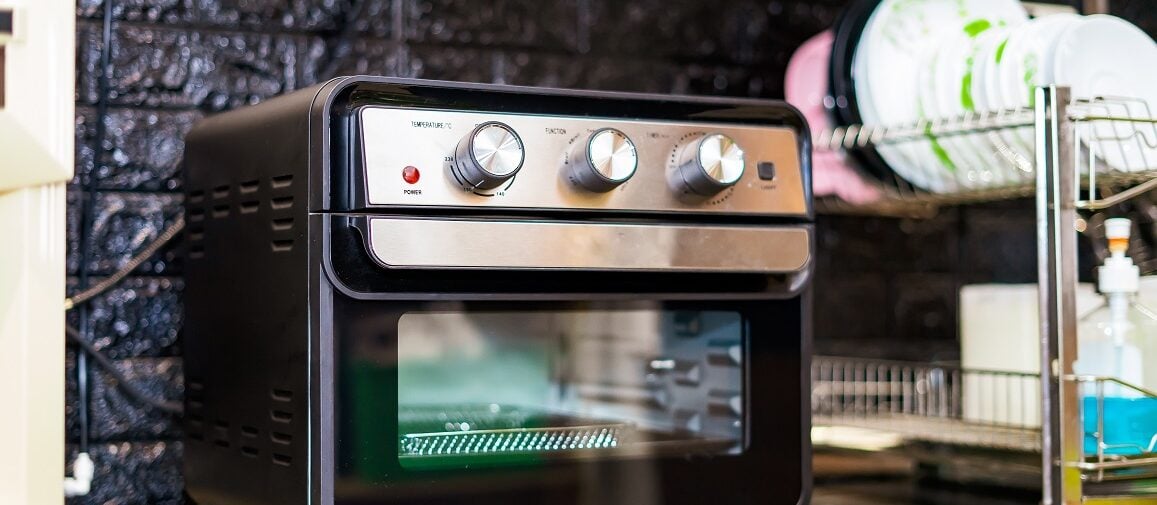
Choosing the right tiny home oven is an important decision, especially when you’re working with limited space or a tight budget. You still want to be able to cook all your favorite meals, but your appliances need to fit in your tiny kitchen without making you claustrophobic.
Luckily, there are lots of options to pick between, from traditional electric or propane ovens which have a built-in stove, all the way down to tiny toaster ovens for your countertop. To help you get started on your search, here’s a list of some of the best tiny house ovens.
When you buy through links on our site, we may earn an affiliate commission. As an Amazon Associate, we earn from qualifying purchases.
Electric or Natural Gas Ranges:
If you love to cook and you have the space and energy resources available in your tiny home, consider an electric, gas, or propane oven with a stovetop — the same kind you’d find in a traditional house. Sure, you might be able to cook food with your tiny home’s wood stove if you really need to, but having a kitchen with a dedicated range gives you more freedom while cooking, and for those with less space, you can find smaller models to fit most tiny kitchens. Below are a few of the best options on the market.
1. Best – High quality tiny stove – Profile 5.3 cu. ft. Electric Range with Steam-Cleaning Convection Oven and Air Fry in Stainless Steel
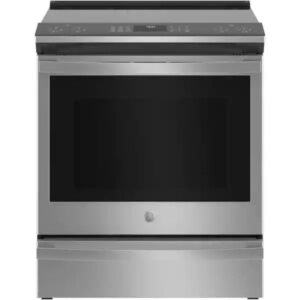
Product specifications
- Fuel Type: Electric
- Voltage: 240V
- Oven Capacity: 5.3 cubic feet
- Dimensions: 29.87” x 37.25” x 28”
- Weight: 200 lbs.
The Good
- Range gets hot quickly, and stays hot
- Wi-Fi compatible, with many helpful features
- Air-frying for crispy food without excess fatty oils
- Finger-print resistant finish
- Self-cleaning mode
- Fit Guarantee
The Bad
- Pricey
- A moderate amount of configuration needed
If your kitchen has the space, this stylish tiny house electric oven can do almost any cooking task you need — including air frying, without needing to preheat. The oven features the True Convection system, which uses a third heating element and a reversing fan for the ideal heat circulation. It’s Wi-Fi enabled, too, so you can manage the oven from anywhere, or just use the classic touch controls on top.
The power boil element, which concentrates heat, is a nice touch, and you won’t need to wait around for ages for water to boil. Plus, with five elements total, you can cook many different components or dishes at once.
2. Unique Appliances Classic Retro 24 in. 2.9 cu. ft. Retro Gas Range with Convection Oven
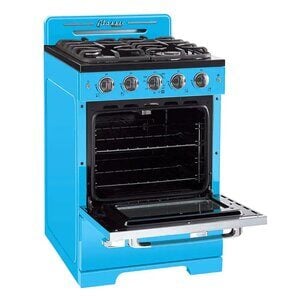
Product specifications
- Fuel Type: Gas
- Voltage: 120V
- Oven Capacity: 2.9 cubic feet
- Dimensions: 39.4” x 24” x 29.5”
- Weight: 156.53 lbs
The Good
- Fun retro design
- High-quality stainless steel construction and chrome-finished accents
- Roomy oven space
- Sealed burners for easy cleanup
- Available in a variety of colors
The Bad
- Some users found the oven sometimes goes out on the first lighting attempt
This robin egg blue-hued gas oven is a bit smaller than our last pick, making it easier to fit in tiny home kitchens with limited space, plus it looks beautiful. It’s a gas stove, so if you’re living in an off-grid tiny home with limited power, it might be easier to use than pure electric ovens — just be aware that it still uses some electricity to ignite and run the convection fan.
There’s also storage on the bottom for your pots and pans, which is convenient. If you’re less bold with your color choices, it’s available in more muted tones too, like summer mint green or a sleek midnight black. Match it with your favorite kitchen appliances for a truly aesthetic space to cook.
3. Summit Appliance 20” Freestanding Gas Range
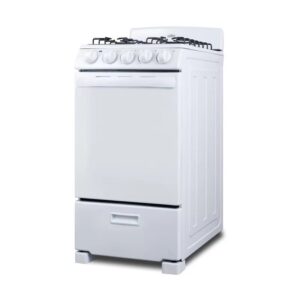
Product specifications
- Fuel Type: Gas
- Voltage: 120V
- Oven Capacity: 2.3 cubic feet
- Dimensions: 42” x 19.5” x 23.5”
- Weight: 130.07 lbs.
The Good
- Affordably priced for the level of quality
- Easy to clean
- Straightforward installation
- Can be manually lit in case of a power failure
- Good for small homes, but still has four burners
The Bad
- Oven space is a bit tight
- Only available in white
For anyone with a tiny space in their kitchen, this is the smallest gas range of the bunch at only 20” — one of the smallest you’ll find available in this oven style. This gas oven has an electric spark ignition, too, and there are four sealed burners on top for clean and safe cooking. The grates are all enameled, so they should last you a long time.
The oven’s interior isn’t the largest, of course, but you should still be able to do most of the baking or broiling you need. There are four positions where the slide-out racks can sit, to help accommodate larger foods like a Thanksgiving… chicken!
Countertop Ovens:
Large electric or gas ovens aren’t the only way to go for your small kitchen. There are some great countertop ovens out there that you probably won’t feel limited by, plus they let you utilize the storage space underneath the counter. So, if you need an extra small oven for your tiny house, consider one of these countertop models.
4. Ninja SP101 Digital Air Fry Countertop Oven with 8-in-1 Functionality
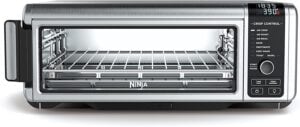
Product specifications
- Dimensions: 19.72” x 7.56” x 14.96”
- Weight: 18.56 lbs.
- Voltage: 120V
- Wattage: 1750W
The Good
- Can cook food many different ways
- Easy to store
- Cooks quickly and efficiently
- Easy to clean
The Bad
- Interior height is too small for something like a roast chicken
This Ninja model isn’t just a countertop oven, but it’s a broiler, pizza oven, air fryer, toaster, dehydrator and more. The interior is quite large, too — you can cook up to a 13” pizza, or four whole chicken thighs, inside. When you’re not using the oven, just flip it upwards against your wall and it can save you some precious counter space. It can’t work as a stovetop, of course, but since it’s so compact, it’s easy to pair with an induction cooktop anyway.
5. Dualit Mini Oven
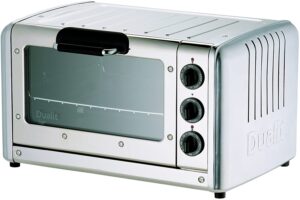
Product specifications
- Oven Capacity: .77 cubic feet
- Dimensions: 31” x 22” x 29”
- Weight: 12.4 lbs.
- Wattage: 1600W
The Good
- Compact design
- Multiple cooking functions
- Durable in the long run
- Easy to clean
The Bad
- Doesn’t have many bells and whistles
Even though the Dualit Mini Oven is super compact, it still has a decently sized cooking area, so you’ll be able to roast or heat up lots of different dishes. The non-stick interior is helpful when it comes time to clean, too, since all you’ll need to do is wipe it down, and there’s a removable tray to get out all the pesky food crumbs.
This countertop oven also heats up quickly — from a starting temperature to 425 degrees-Fahrenheit in just under nine minutes — so you won’t need to stand around for ages waiting to put in your pizza.
6. Dash Mini Toaster Oven
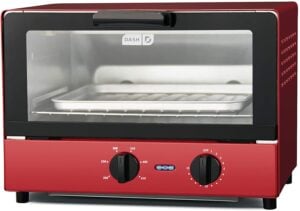
Product specifications
- Dimensions: 7.7” 6.3” 7.2”
- Weight: 3.2 lbs.
- Wattage: 550W
The Good
- Cute color and design
- Perfect for toasting small foods
- Automatic shut off
- Easy to clean
The Bad
- The very small size significantly limits what you can cook
Ovens don’t get tinier than this mini toaster oven from Dash! You obviously won’t be able to cook normal dinners in it, but if you’re just heating up a sandwich, half a bagel, or breakfast roll in the morning, you’ll save a lot of time and electrical energy. It comes in a cheery yellow color with lots of vintage charm, so it’ll look great in your tiny kitchen.
Cleanup is a breeze, too, since the removable parts inside, like the rack, baking tray and crumb tray, are all dishwasher safe. Plus, it’s easy on the wallet, so adding it to your kitchen isn’t really a huge investment. It’s a cheap buy, so if you break it you may be able to buy another one :P. Ultimately, you’re not cooking anything larger than a pizza in here!
Microwave Ovens:
If you don’t really cook that much and don’t need a whole oven, or you’re trying to build a tiny home on a very tight budget, maybe a simple microwave like the one below is all you need for your meals.
7. LG 1.5 cu. ft. NeoChef Countertop Microwave
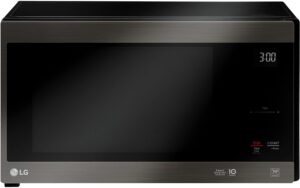
Product specifications
- Oven Capacity: 1.5 cubic feet
- Dimensions: 21.41” x 12.13” x 17”
- Weight: 26 lbs.
- Voltage: 120V
- Wattage: 1200W
The Good
- Sleek exterior that wipes clean easily
- Compact, but spacious on the inside
- Heats up food quickly
- Anti-bacterial coating inside, which resists stains
The Bad
- Some users said theirs stopped working sooner than they hoped
The LG NeoChef Countertop Microwave has a very large interior for a microwave oven, and it’s built with sensor cooking technology that can automatically adjust cooking time and power when needed. And don’t be fooled, microwaves aren’t only great for reheating food. Many professional chefs use microwaves on the daily, for things like rice, steaming vegetables, or even pre-cooking meats before giving them a final sear in a pan.
This one also has an interesting turntable I’ve never seen used before. Instead of the usual three wheels, the spinning plate has six, which keeps it more stable and stops your dishes from tipping and slipping.
We hope this list helps you on your journey to find the perfect oven for your space. If you still have any questions about tiny home ovens, read on for some answers!
Frequently asked questions about Tiny stove or Ovens.
While there are lots of different options to choose from, a classic electric or gas range is probably the best combination of a stove and oven. If you don’t have space for even the smallest options, you could also use a countertop oven and a burner cooktop and keep them safely stored away when not in use.
Micro-kitchens are essentially just compact kitchens, with every appliance working together to take up as little space as possible. Most micro-kitchens still have all the essentials of some kind in a small space, like a stove, oven, fridge, and dishwasher, so building one doesn’t mean sacrificing functionality. See our other tiny house kitchen guide if you need any help planning your kitchen efficiently, and check out our list of some of the best tiny house appliances to set your yourself up for success.
It’s definitely possible to fit all three of these appliances in your tiny house but finding them all together in one unit or to DIY can be a challenge for the average consumer. Some designers and architects have achieved this, though, so consider having your tiny house professionally designed if you really want your kitchen as condensed as possible. There are also little portable tools you can buy to turn your tiny house sink into a dishwasher, if you’d like, or handwashing your dishes isn’t the worst thing.
Start by figuring out the size of oven you’ll need, and what kind of power you’ll be able to supply to the oven. If you’re living in an off-grid tiny home, for example, you might be reliant on solar power, which probably won’t be able to power your electric oven on a cloudy day. Using a propane oven might be best in that situation, but otherwise, gas and electric ranges or countertop ovens are your friend. Make sure you set up the appropriate venting, too!
Besides making sure your new tiny house oven fits in your budget, the other most important thing you should be looking for is the functionality. Do you need your oven to have a built-in stove, or would you prefer a countertop oven to cook your meals? Do you really need an oven, or do you just want an induction cooktop and a microwave? Answering questions like these will help you figure it out. But, if you want an appliance that won’t limit your cooking, opt for an electric or gas range.
7 of the Best Tiny House Bed Ideas
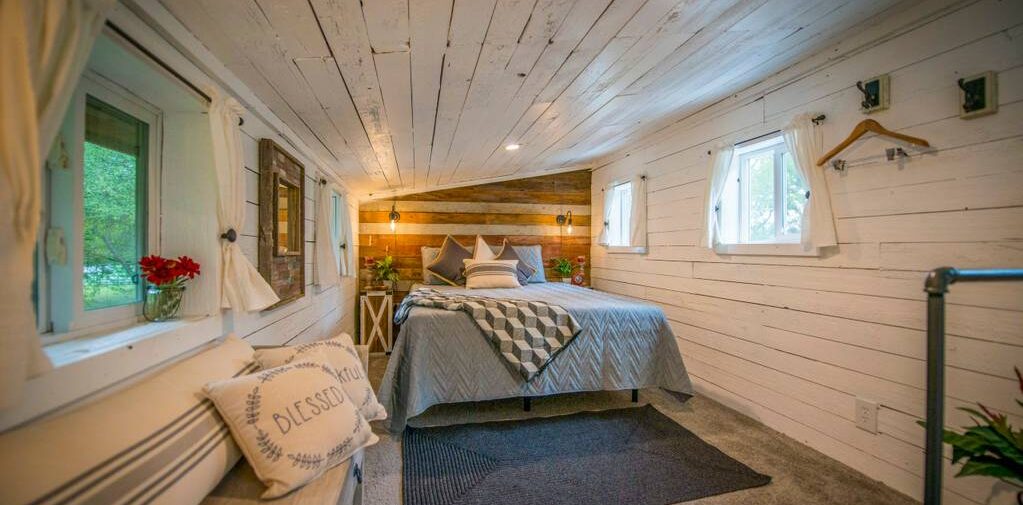
Having a minimalist tiny home usually means you’re working with less space than a traditional house, but that doesn’t mean you need to have a small or uncomfortable sleeping area. You just need to get creative.
There are lots of great tiny house bed ideas to draw from, from loft-style setups to DIY elevator beds, that are all designed to maximize the horizonal and vertical space in your bedroom design, so that everything in your tiny house works together in harmony.
If you’re building a new home, or want to improve the one you already own, here’s a list of our favorite bedroom ideas for small spaces to inspire you.
When you buy through links on our site, we may earn an affiliate commission. As an Amazon Associate, we earn from qualifying purchases.
1.Loft Bedroom
Loft bedrooms are one of the most popular bed styles for tiny houses with limited space. Think of them like an attic — they’re usually on the second floor of your tiny home and accessible by stairs, where you can put your bed to sleep on.
Loft bedrooms take advantage of your vertical space, and you won’t have to worry about a bed taking up tons of room in your floor layout. You can also use the space underneath the loft for something like a kitchen or living area, and they’re wonderful for tiny homes that need multiple bedrooms, since you can put an extra bed below.
You could also try building a tiny house loft bed with a hammock underneath on the main floor, so you have one spot for a restful night’s sleep, and another just for a calm afternoon nap. You don’t necessarily need a narrow mattress, either — lofts typically have plenty of room.
Here’s some tips for choosing a new mattress for your loft bedroom, and we think that Ikea’s Morgedal foam mattress is an affordable and comfortable choice to buy. Plus, if you do happen to have a tighter loft, it’s thin enough to comfortably fit.
Ikea Morgedal Form Mattress
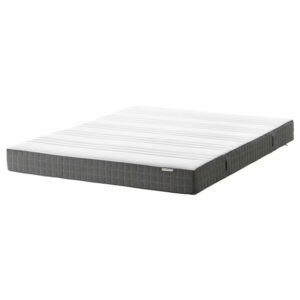
Product specifications
- Comes in Twin, King, Queen and Full sizes.
The Good
- 10 year limited warranty
- Foam
- Firm
- Roll packed
- Washable cover
2. Beds by a Window
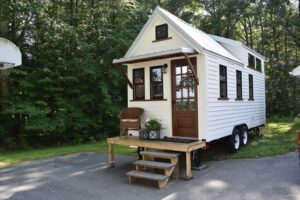
Natural light is important for tiny homes, since it can brighten up your small space and make it appear larger and more open. Putting your bed by the windows lets in plenty of light — and waking up in the morning to gentle beams of sunlight on your face is a wonderful feeling.
This farmhouse style tiny house on wheels in Connecticut makes great use of windows on the sides of the bed in their loft bedroom. Natural light from four large windows by the bed fills the space, which makes the whole vibe more open and breezier.
If your tiny home, RV, or shipping container is situated somewhere off-grid in nature, you’ll probably have a relaxing view while you’re chilling in bed. Imagine looking out at a beautiful forest, while listening to calming raindrops patter against the glass? Sign me up!
3. Murphy Beds for Small Spaces
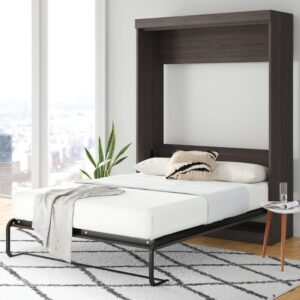
Murphy beds are another one of the best bed designs for small rooms since they’re easy to store away. They fold up neatly into a contained unit, so that you can make the most of your tiny space while you aren’t asleep. When you need to get some shut eye, just pull the mattress down and lock the bed into place.
There was some fear in the past that Murphy beds could close on you while you’re sleeping. That’s happened before with some earlier models when it was first invented, but with modern tech, it’s not something you should worry about. Just be careful when you’re packing it away, and you’re golden!
Check out the popular and comfy Colquitt Murphy Bed if you’re in the market for one — it comes in four different colors, including a sleek white or bark grey, and you can get it either full or queen sized.
Here’s another fancier murphy bed to check out from Zoom-Room if you love the idea of hide away beds for small spaces. Their SmartBeds are motorized murphy beds, so you wouldn’t need to manually pull it up and down every day, and they roll up into their own handy cabinet with the click of a button.
Colquitt Murphy Bed from Wayfair
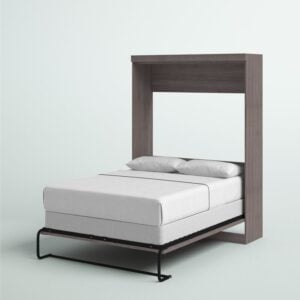
Product specifications
- Frame Material: Manufactured Wood
- Box Spring Required: No
- Mattress Included: No
- Weight Capacity: 1000 lb
- Adult Assembly Required: Yes
- Compatible with Adjustable Bed: No
- Recommended Mattress Thickness (Queen Size): 12”
- Recommended Mattress Thickness (Full Size): 10′
Comes in Full and Queen size.
4. Beds with Storage Space
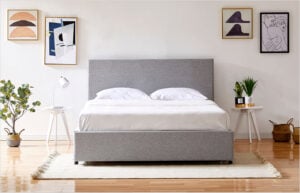
When you’re living in a tiny home, it’s important that you make the most out of any space you’re given, and that includes your bed.
There’s lots of opportunity to integrate more storage into your bedroom, so here are some storage ideas. If you love to read, for example, try using the walls around you as vertical storage and build a wooden shelf for your books. Your favorite novel will always be within reach to read before falling asleep.
There are also plenty of storage beds that are built with drawers or cupboards underneath, or that you can pull up with hinges, so you have some extra room to keep all your clothes or trinkets safely tucked away.
For those looking for a new storage bed for their small house, we think that the Silk & Snow Bed Frame is a great choice. It’s sleek and well designed, and it’s not obvious that it doubles as storage.
Silk & Snow – Bed Frame with Storage
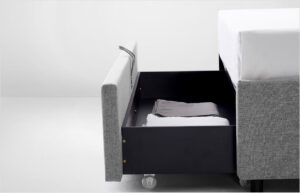
Product specifications
- One drawer at foot of the bed provides ample storage space
- Unobtrusive design with a minimalist aesthetic
- Designed in Canada
- Financing available
- Add-ons, small night stand and Duvet
- Comes in three colors (Pebble, Oatmeal and Granite)
- Slats are optimized for no noise!
Comes in Full, Queen and King sizes.
5. Tiny House Bunk Beds
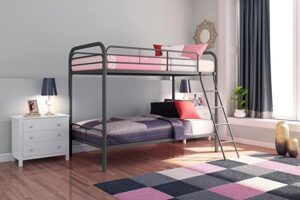
You can also maximize your vertical space in small bedrooms using bunk beds, which are a classic for kids who need to share a room. The top bed is accessible with a ladder, and sometimes you’ll even find models with added storage underneath for even more functionality.
Some bunk bed models have a desk underneath instead, so you can easily set up a little workspace in your tiny home if you just need a sleeping area for yourself.
Looking for a bunk bed to buy? We like the Twin Over Twin Metal Bunk Bed from DHP — it’s affordable, sturdy, has extra storage built-in, and comes in plenty of colors. You can opt for the twin over full, too, if you have a younger and an older kid.
DHP Twin Over Twin, Metal Bunk Bed – Silver on Amazon
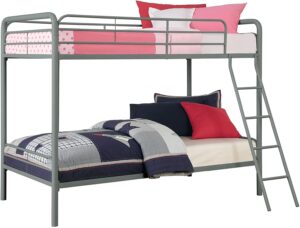
Product specifications
- Size: Twin/Twin
- Material: Metal
- Color: Silver
- Furniture finish: Metallic
- Style: Bunk Bed
- Brand: DHP
- Item Weight: 74 Pounds
- Maximum weight recommendation: 225 Pounds, 200 Pounds
- Product Dimensions: 19
Only in Twin/Twin configuration.
6.Multifunctional Convertible Beds
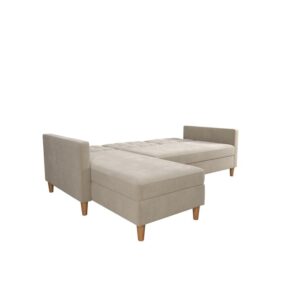
Also called sofa beds, these look like a couch during the day, but when it’s time to sleep, a mattress can be pulled from behind the seating cushions to form a bed.
They’re the ideal piece of furniture for almost any living room space, and they’re a great way to have an extra space for your guests to sleep.
One of the best convertible beds for small rooms is the Kayden 84″ Wide Reversible Sleeper Sofa & Chaise that comes in a stylish blue chenille color. It converts into a cozy queen-sized bed, and the chaise has some added storage space for pillows, blankets, or anything else.
Kayden 84″ Wide Reversible Sleeper Sofa & Chaise on Wayfair
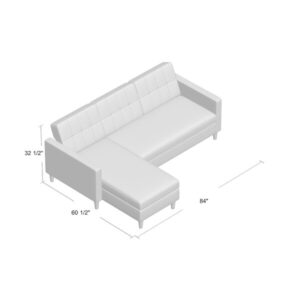
Product specifications
- What’s Included: 1 Chaise, 1 Sofa, Ottoman
- The sleeper sectional converts into a queen-size bed when reclined and used with the ottoman (sold separately.)
- Storage Space Included: Yes
- Seating Capacity: 3
- Cushion Construction: Foam
- Design: Sleeper
7. DIY Retractable Ceiling Bed

As seen in the Te Whare Nukunuku modern tiny house in New Zealand, DIY retractable ceiling beds (also called elevator beds) can be a handy space saver. The bed itself is stowed near the ceiling, and when it’s time for shut eye, it can be brought down closer to the floor using a hand crank.
This home also has a sofa bed underneath with extra storage, and if the ceiling bed is pulled down halfway, there’s two spots for people to sleep — it’s like a bunk bed.
Overall, these DIY ceiling beds are a useful sleeping solution, but they can be harder to buy. You’ll likely need to hire a professional to make one for you — or learn how to do the woodworking yourself.
Frequently Asked Questions about Tiny House Bedrooms
What is the most common sleeping arrangement for tiny house living?
The three most popular sleeping arrangements for a tiny home’s house design are loft bedrooms, murphy beds and bunk beds. While we covered them above, here’s a quick review and comparison:
Loft Bedrooms — Lofts, like the 53.75 square feet per person tiny cabin in France, are on the second floor and accessible by a ladder, so you’re free to have open spaces below without needing to account for a whole bed.
Murphy Beds — These are great room saver beds since they tuck up out of the way when not used as a sleeping space. Some models also work as cabinets, which can give you even more room to store your things.
Bunk Beds — These aren’t just great for kids and teens, but you can use them for more than one person to sleep comfortably in a tight space. Some bunk beds have a desk underneath instead, or can have a little living area underneath, so there are many ways to use them.
If you need even more bed inspiration, tiny home tour videos online are a helpful resource to see how others have designed their small bedrooms.
How can you fit a king size bed in a tiny house?
Fitting a king mattress and bed in your tiny home will require some creativity, just like with small apartments, but for those who need a roomy spot to sleep, you can probably do it. First, you’ll need to double check there’s a room with enough space for it. If you haven’t already built your tiny home yet, see our article here for some tiny house floor plan inspiration and make a bedroom big enough, or, hire an architect to design it for you.
From there, you can use many of the popular sleeping arrangements mentioned above to fit your king bed and make the most of your space. Loft or murphy style beds will be your best bet, since trundles and bunks don’t often come in king. But, if your tiny home doesn’t have the space to fit a king mattress even just lying flat, I’m sorry to say you won’t have much luck!
What is a trundle bed, and why is it good for a tiny home?
Another style you’ll often see is called a trundle bed. It’s a bed that has another one underneath that rolls out, so that you can have an extra sleeping spot. You’ll usually find them in twin or single sizes, which means they won’t take up too much space when bundled together.
Trundle beds can be a great choice for homeowners with downstairs bedrooms or guest rooms, since they’ll be out of the way and can expand to fit more people (hello, sleepovers!). The Barrett Twin Solid Wood Daybed from Trule is a well-made, comfortable option, that teens and kids especially would love.
Loft bed vs. Murphy bed vs. trundle bed, which one is better?
Loft bedrooms are probably the best of the three for your living space, since they utilize so much vertical room that’s easy to waste otherwise, and they can usually fit larger mattresses. If you don’t already have a loft built into your tiny home, though, or don’t have the means to add one, you’re out of luck there. Murphy beds and trundle beds are both effective space savers when you can’t change up the tiny house itself.
What are some of the other best sleeping solutions for small spaces?
Hammock Bed — Some people don’t need a traditional mattress to sleep on and prefer something more fun in their small home, like a hammock bed. You can make an entire loft out of a hammock to sleep on, which is a clever way to create more space without changing up the infrastructure.
Water Bed — If your home has enough room for one, water beds are another great alternative with some added health benefits. They conform to your body effectively, so there’s no resistance or pressure on your joints.
What are some important things to look for in buying a bed for a tiny home?
Choosing a bed idea for your tiny house comes down to three important factors: space, budget, and comfort.
Space — You need to choose a bed that’ll fit in your space. Depending on how small your tiny home’s dimensions are, you might be limited to specific sleeping solutions. If you don’t have a loft, for example, and don’t have the space or resources to build one, you might need to consider a Murphy or convertible bed to make the most of your bedroom.
Budget — You’ll also need to think about your budget, and some tiny house bed ideas are more costly to install than others. Murphy beds, for example, can run you at least a couple thousand dollars, so if you already have a loft space you need to fill and don’t want to spend too much money, getting a mattress for your loft might be the best idea. Some of the design ideas here are mostly DIY, too, like the retractable ceiling beds or hammock beds, so they can be cheaper to set up if you’re willing to put in the elbow grease.
Comfort — Don’t pick a bed that isn’t comfy for you! You know your body and sleeping style best but try to go for a nice memory foam mattress or water bed that’ll be cozy on your back, and don’t choose something like a hammock bed if it won’t support your body properly.